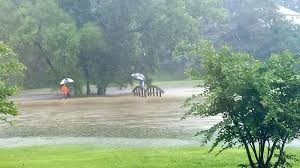Most of last month was dreary, cloudy, misty, and generally not inducing to outdoor events. The third week was almost a constant downpour. At my house we received around seven inches of rain. We live on the top of a low ridge. Often when I looked out my office window I saw multiple puddles of water. No flooding, but what is locally known as scattering.
Throughout North Texas many creeks and streams start in a pasture before flowing downstream to merge with other creeks that form such rivers as the Wichita, the Brazos, the Sulphur, the Trinity, the Sabine, the Pease, and Pecan Bayou along with the Red River. Those are ones found in the first two tiers of counties along the Red River from Bowie County to the Panhandle. Into each river flow countless streams, branches, and creeks. Many names for these waterways are repeated as one moves westward from the Arkansas boundary. Brushy Creek, Salt Creek, Elm Creek and Pine Creek are examples of replications.
Obviously waterways end in a river before flowing into the Gulf of Mexico. Streams are smaller waterways that flow into the river. Creeks and branches are often dry, filled with water only after large rains. As would be expected, the deeper the river the higher the banks are in dry weather. The Sulphur River crosses Hunt County as the Middle and South Sulphur. The South branch has high banks in places while the Middle Sulphur tends to cover large areas after a rain.
Scatter Branch, a small waterway, heads up or begins near the South Sulphur. It was an early settlement and had a school in the early 1900s. In dry weather it is difficult to locate the waterway, but after a heavy rain the fields and pastures are covered with sheets of water. In 1974 one very heavy thunderstorm unloaded massive amounts of rain in the vicinity. An old county bridge was completely washed away. The bridge connected the community of Scatter Branch with the towns of Commerce and Greenville. With the loss of the bridge residents found themselves having to go to Commerce before back tracking to Greenville. Today, forty years later, the bridge has not been replaced. However, it must not be such an inconvenience since nice new homes now dot the landscape. Needless to say, the school was consolidated with the Commerce School District much earlier.
While livestock raising is one of the agricultural endeavors in this section of Texas, cattlemen are not happy when a creek or branch scatters. The water has a tendency to stand in the fields that are already saturated. Cattle and goats that stand in such water tend to be infected with a disease known as “hoof rot,” a bacteria that rots away the foot between the two toes of the affected animal. It is painful and contagious but can be treated.
The rains last month were indicative of those that follow drought conditions. While some parts of Texas had been without rain for more than 200 days, our part of the state was not in such a bind. Outdoor burning was not allowed, people worried about the water availability for spring and summer, and meteorologists kept us posted on the drought.
Anecdotal evidence shows that after a drought huge amounts of rain follow. There are numerous stories from the 19th century about cowboys trying to cross a stream, losing control of his horse, and drowning. Most of these followed a drought.
But we are thankful for our February rains.


There is a cemetery called Scatter Branch. You have to want to find it but it’s worth the visit, when it’s dry.
I actually live in Scatterbranch. I’ve been here since the early 90’s. I moved to the area as a small girl with my mother and father. We raised & breed horses. My mother and father has passed away but I still live here.